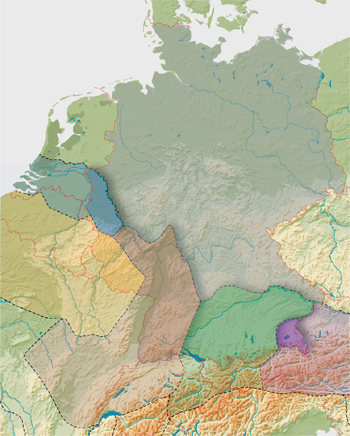The larger part of modern Germany was outside the Roman empire, which only extended across the western and southern parts of the country. Remains of the Roman occupation, which lasted from the first to the fifth centuries AD, can only be found in the present states of Nordrhein-Westfalen, Rheinland-Pfalz, Saarland, Hessen, Baden-Württemberg and Bavaria. In the Roman period these areas comprised five separate provinces: Germania Inferior, Germania Superior, Raetia and Noricum and Gallia Belgica. The first four were frontier provinces, with their own armies, but the borders of Gallia Belgica were entirely within the empire. The four frontier provinces extended into other modern countries apart from Germany. Germania Inferior covered not only Nordrhein-Westfalen but also the southern part of the Netherlands. Rheinland-Pfalz, Hessen and Baden-Württemberg were in Germania Superior, as were also western and northern Switzerland and an area of eastern France. Raetia consisted of parts of Baden-Württemberg and Bavaria, and also eastern Switzerland and the southern Tirol. Most of Noricum was in Austria, but its western part extended into a small area of Bavaria. The development of Mediterranean ways of life and their blending with local elements produced a distinctive type of Roman culture in the northern frontier provinces. Its development in individual provinces depended on how and when they were incorporated in the Roman empire, and therefore different aspects of this culture are always examined province by province in the Transformation Website.
|

|